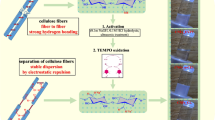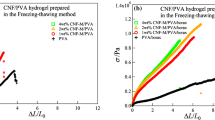Abstract
In this work, dynamic mechanical properties of the grown bacterial cellulose (BC) nanofibers were investigated. BC pellicles were fabricated using bacterial fermentation (Gluconacetobacter xylinus). The morphology results confirmed that the dried BC at ambient conditions could be categorized as a xerogel. The thermal dynamic mechanical analysis results indicated that the bound water in bacterial cellulose structure had a very significant effect on thermal and dynamic mechanical properties of BC pellicles. The results of dehydration kinetics study showed that the main mechanism governing water loss of BC was Fickian diffusion. The glass transition temperatures (Tg) of the BC dried at 25 °C (ambient temperature) and 105 °C were estimated − 33 and − 18 °C, respectively. This discrepancy can be attributed to the plasticizing effect of the bound water of BC dried at ambient temperature. Furthermore, the results indicated that its modulus drop smaller than one order of magnitude can be attributed to its high crystalline nature. The storage modulus versus frequency increased due to the limitation of the relaxation process of the polymer chains. Moreover, the relaxation time distribution was achieved from the slope of the modulus master curve versus logarithmic frequency. As a result, BC exhibited a solid-like behavior.






Similar content being viewed by others
References
Ebrahimi E, Babaeipour V, Khanchezar S (2016) Effect of down-stream processing parameters on the mechanical properties of bacterial cellulose. Iran Polym J 25:739–746
Budhiono A, Rosidi B, Taher H, Iguchi M (1999) Kinetic aspects of bacterial cellulose formation in nata-de-coco culture system. Carbohydr Polym 40:137–143
Sai H, Fu R, Xing L, Xiang J, Li Z, Li F, Zhang T (2015) Surface modification of bacterial cellulose aerogels’ web-like skeleton for oil/water separation. ACS Appl Mater Interfaces 7:7373–7381
Kang YJ, Chun S-J, Lee S-S, Kim BY, Kim JH, Chung H, Lee S-Y, Kim W (2012) All-solid-state flexible supercapacitors fabricated with bacterial nanocellulose papers, carbon nanotubes, and triblock-copolymer ion gels. ACS Nano 6:6400–6406
Wanichapichart P, Taweepreeda W, Nawae S, Choomgan P, Yasenchak D (2012) Chain scission and anti fungal effect of electron beam on cellulose membrane. Radiat Phys Chem 81:949–953
Ul-Islam M, Khan T, Park JK (2012) Nanoreinforced bacterial cellulose-montmorillonite composites for biomedical applications. Carbohydr Polym 89:1189–1197
Müller A, Zink M, Hessler N, Wesarg F, Müller FA, Kralisch D, Fischer D (2014) Bacterial nanocellulose with a shape-memory effect as potential drug delivery system. RSC Adv 4:57173–57184
Klemm D, Schumann D, Udhardt U, Marsch S (2001) Bacterial synthesized cellulose—artificial blood vessels for microsurgery. Prog Polym Sci 26:1561–1603
Lee KY, Buldum G, Mantalaris A, Bismarck A (2014) More than meets the eye in bacterial cellulose: biosynthesis, bioprocessing, and applications in advanced fiber composites. Macromol Biosci 14:10–32
Oh SY, Yoo DI, Shin Y, Seo G (2005) FTIR analysis of cellulose treated with sodium hydroxide and carbon dioxide. Carbohydr Res 340:417–428
Lee K-Y, Quero F, Blaker JJ, Hill CAS, Eichhorn SJ, Bismarck A (2011) Surface only modification of bacterial cellulose nanofibres with organic acids. Cellulose 18:595–605
Hsieh Y-C, Yano H, Nogi M, Eichhorn SJ (2008) An estimation of the Young’s modulus of bacterial cellulose filaments. Cellulose 15:507–513
Grunert M, Winter WT (2002) Nanocomposites of cellulose acetate butyrate reinforced with cellulose nanocrystals. J Polym Environ 10:27–30
Park J-S, Park J-W, Ruckenstein E (2001) Thermal and dynamic mechanical analysis of PVA/MC blend hydrogels. Polymer 42:4271–4280
Wu YB, Yu SH, Mi FL, Wu CW, Shyu SS, Peng CK, Chao AC (2004) Preparation and characterization on mechanical and antibacterial properties of chitsoan/cellulose blends. Carbohydr Polym 57:435–440
Siqueira G, Bras J, Dufresne A (2009) Cellulose whiskers versus microfibrils: influence of the nature of the nanoparticle and its surface functionalization on the thermal and mechanical properties of nanocomposites. Biomacromol 10:425–432
Liu H, Liu D, Yao F, Wu Q (2010) Fabrication and properties of transparent polymethylmethacrylate/cellulose nanocrystals composites. Bioresour Technol 101:5685–5692
Petersson L, Kvien I, Oksman K (2007) Structure and thermal properties of poly(lactic acid)/cellulose whiskers nanocomposite materials. Compos Sci Technol 67:2535–2544
Bondeson D, Oksman K (2007) Polylactic acid/cellulose whisker nanocomposites modified by polyvinyl alcohol. Compos Part A Appl Sci Manuf 38:2486–2492
Szcześniak L, Rachocki A, Tritt-Goc J (2008) Glass transition temperature and thermal decomposition of cellulose powder. Cellulose 15:445–451
Yano S, Maeda H, Nakajima M, Hagiwara T, Sawaguchi T (2008) Preparation and mechanical properties of bacterial cellulose nanocomposites loaded with silica nanoparticles. Cellulose 15:111–120
Ciechańska D (2004) Multifunctional bacterial cellulose/chitosan composite materials for medical applications. Fibres Text East Eur 12:69–72
Sirousazar M, Kokabi M, Yari M (2008) Mass transfer during the pre-usage dehydration of polyvinyl alcohol hydrogel wound dressings. Iran J Pharm Sci 4:51–56
Shezad O, Khan S, Khan T, Park JK (2010) Physicochemical and mechanical characterization of bacterial cellulose produced with an excellent productivity in static conditions using a simple fed-batch cultivation strategy. Carbohydr Polym 82:173–180
Ul-Islam M, Khan T, Park JK (2012) Water holding and release properties of bacterial cellulose obtained by in situ and ex situ modification. Carbohydr Polym 88:596–603
Landel RF, Nielsen LE (1993) Mechanical properties of polymers and composites, 2nd edn. CRC Press, Boca Raton
Aegerter MA, Leventis N, Koebel MM (2011) Aerogels handbook. Springer-Verlag, New York
Pirard R, Blacher S, Brouers F, Pirard JP (1995) Interpretation of mercury porosimetry applied to aerogels. J Mater Res 10:2114–2119
Lee KY, Bismarck A (2012) Susceptibility of never-dried and freeze-dried bacterial cellulose towards esterification with organic acid. Cellulose 19:891–900
Wong S-S, Kasapis S, Tan YM (2009) Bacterial and plant cellulose modification using ultrasound irradiation. Carbohydr Polym 77:280–287
Yan Z, Chen S, Wang H, Wang B, Jiang J (2008) Biosynthesis of bacterial cellulose/multi-walled carbon nanotubes in agitated culture. Carbohydr Polym 74:659–665
Barud HS, Ribeiro CA, Crespi MS, Martines MAU, Dexpert-Ghys J, Marques RFC, Messaddeq Y, Ribeiro SJL (2007) Thermal characterization of bacterial cellulose–phosphate composite membranes. J Therm Anal Calorim 87:815–818
Vittadini E, Dickinson LC, Chinachoti P (2001)) 1H and 2H NMR mobility in cellulose. Carbohydr Polym 46:49–57
Ford JL (1999) Thermal analysis of hydroxypropylmethylcellulose and methylcellulose: powders, gels and matrix tablets. Int J Pharm 179:209–228
Hancock BC, Zografi G (1994) The relationship between the glass transition temperature and the water content of amorphous pharmaceutical solids. Pharm Res 11:471–477
Barud HS, Souza JL, Santos DB, Crespi MS, Ribeiro CA, Messaddeq Y, Ribeiro SJL (2011) Bacterial cellulose/poly(3-hydroxybutyrate) composite membranes. Carbohydr Polym 83:1279–1284
Jandura P, Riedl B, Kokta BV (2000) Thermal degradation behavior of cellulose fibers partially esterified with some long chain organic acids. Polym Degrad Stab 70:387–394
Hou G, Li N, Han H, Huo L, Gao J (2015) Hybrid cationic ring-opening polymerization of epoxy resin/glycidyloxypropyl-polyhedral oligomeric silsesquioxane nanocomposites and dynamic mechanical properties. Iran Polym J 24:299–307
Goodarzi V, Kokabi M, Razzaghi Kashani M, Bahramian AR (2014) Prediction of long-term mechanical properties of PVDF/BaTiO3 nanocomposite. J Appl Polym Sci 131:40596. https://doi.org/10.1002/app.40596
Pothan LA, Oommen Z, Thomas S (2003) Dynamic mechanical analysis of banana fiber reinforced polyester composites. Compos Sci Technol 63:283–293
Nair KCM, Thomas S, Groeninckx G (2001) Thermal and dynamic mechanical analysis of polystyrene composites reinforced with short sisal fibres. Compos Sci Technol 61:2519–2529
Acknowledgements
The authors would like to thank Tarbiat Modares University and Iran Nanotechnology Initiative Council (INIC) for their supports.
Author information
Authors and Affiliations
Corresponding author
Electronic supplementary material
Below is the link to the electronic supplementary material.
Rights and permissions
About this article
Cite this article
Hosseini, H., Kokabi, M. & Mousavi, S.M. Dynamic mechanical properties of bacterial cellulose nanofibres. Iran Polym J 27, 433–443 (2018). https://doi.org/10.1007/s13726-018-0621-x
Received:
Accepted:
Published:
Issue Date:
DOI: https://doi.org/10.1007/s13726-018-0621-x




